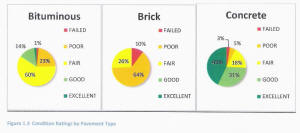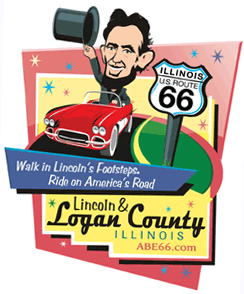|
 Inside the report, Forgy included several pie charts showing the
conditions of the streets in the city and said that street repairs
and reconstruction projects would be prioritized in the five-year
plan according to their rating. Inside the report, Forgy included several pie charts showing the
conditions of the streets in the city and said that street repairs
and reconstruction projects would be prioritized in the five-year
plan according to their rating.
The system for rating city streets was based on the
PASER
program developed by the University of Wisconsin
and used by many municipalities in determining the condition of
their streets. "PASER" represents pavement surface evaluation and
rating.
Forgy said the PASER had been modified slightly by Prairie
Engineers to include an additional grading point: ridability. He
explained the firm wanted to take into account how smooth the road
was and how easy it was to traverse the street comfortably.
For the rating system, the streets of Lincoln were divided into
three types: minor arterial, collector and local urban.

Minor arterial streets are those such as Fifth Street west of
Lincoln Parkway, Broadway, and Union between Fifth and Woodlawn.
They are classified as such because they are primary thruways for
the city and experience higher volumes of traffic.
One street that is not included in this is Woodlawn/Keokuk
because that is considered a state route and maintained by the
Illinois Department of Transportation. Other streets that are not
included are Fifth Street east of Lincoln Parkway and Kickapoo north
of Keokuk for the same reason. Forgy also noted these types of roads
are generally traversed at slightly higher speeds than other city
streets.
Collector streets are streets that do experience traffic volume
but at lower rates than the arterials. They are also traversed at
lower rates of speed. Examples of collector streets include College
Street north of Woodlawn, Pulaski Street and Logan north of Keokuk.
Local urban streets are basically all other city streets. These
are generally the streets inside the city where traffic speeds and
volumes are considerably lower than the other two classifications.
Examples of local urban streets are Pekin, Tremont, Delavan, Wyatt
Avenue, all the numbered streets in the city and many more. By far
the majority of the streets in the city of Lincoln fall under this
classification.

Forgy presented pie charts showing how each class of street
rated. Prairie Engineers found that for the arterial streets, 6
percent of the total failed to make a "passing" grade. In other
words these streets are in dire need of repair or reconstruction.
Eight percent were rated poor, 45 percent good, and none rated
excellent.
In contrast, 16 percent of the collector streets were rated
excellent and none made a failing grade.

Of all the local urban streets, 57 percent were rated as fair,
which means they are deteriorating but are not necessarily going to
be a priority for repair or reconstruction. In addition, 27 percent
rated as poor and 2 percent failed. Only 3 percent of the local
urban roads were considered to be in excellent condition.
Forgy also offered a summary statement of the overall condition
of all the city streets regardless of their classification. In that
summary 2 percent failed, 24 percent were in poor condition, 55
percent in fair, 14 percent in good and 5 percent in excellent
condition.

The report also offered a grade for the streets according to
their construction. Not surprisingly, brick streets in the city of
Lincoln did poorly on their grades. Forgy reported that not any of
the brick streets were in excellent or even good condition. Ten
percent scored a fail, 64 percent were rated poor, and only 26
percent received a rating of fair.
Streets with a bituminous or asphalt surface rated a little
better, with 60 percent in fair condition and 14 percent in good
condition.
Concrete surfaces won out, with 43 percent receiving an excellent
rating and only 3 percent scoring a fail.
[to top of second column] |

During discussion, Tom O'Donohue questioned a designation for
Kickapoo Street. According to the maps Forgy had provided, Kickapoo
is under state jurisdiction from the downtown area all the way north
to the 55 loop. O'Donohue said he didn't believe the state
maintained the street south of Keokuk. Forgy said he would look into
that and make a correction to the map if it was needed. He also
noted there was some question on Feldman Drive. He said according to
IDOT, that street is under their jurisdiction. He said he was also
going to investigate that further.
Jonie Tibbs noted on the city map the section of Pulaski Street
that had received a good condition rating. She said that street was
concrete and had been done in 1991. She wondered what method of
resurfacing was the most expensive.
Forgy said using brick was obviously the most expensive. He said
that recently the cost of using concrete is close to the cost of
using bituminous, but still a little higher. However, the life span
of concrete is much longer, which makes it an economical choice for
the long term. Forgy also noted that as an engineer, he likes the
choice of concrete for reconstruction projects for those reasons.
Tibbs also asked about curb and guttering, noting parts of town
where such does not exist. She asked if in the five-year plan, curb
and guttering would automatically be added to reconstruction
projects. Forgy said not necessarily. The ratings for the streets
did not take into consideration curb and guttering, nor was any
rating given to sidewalk condition or the lack of sidewalks. Forgy
said those are things that will be considered in the project plans.

As far as automatically adding curb and guttering where there is
none now, Forgy said that would depend on the existing drainage. If
there are no storm sewers and there are ditches and natural
waterways that do work, curb and guttering may not be used.
On the other hand, acknowledging a specific example Tibbs had
given where flooding was an issue, he said it could be determined
that part of the reconstruction of a street would include adding
storm sewers and curb and guttering.
Forgy also said he would encourage the aldermen to share with him
concerns they get from their constituents. There is very little
history on record for what has been done in the past on the city
streets. Forgy said because they are not aware of issues or
complaints, there may be areas of the city that need attention, but
aldermen don't necessarily know about it.
Mayor Keith Snyder asked him how soon he needed feedback from the
community, and Forgy said the quicker the better. With the street
ratings now completed, Prairie Engineers has begun moving forward
with the development of a five-year plan. The firm is prioritizing
major projects according to the ratings and any other input they
receive.
Forgy also told the council that the information gathered in the
ratings study will be incorporated into the local GIS database,
where it will become public information.
Also during the conversations, Forgy said the ratings had been
done with no politics involved. There had been no influences to rate
one street as better or worse based on opinion.
As the conversations came to an end, Snyder commented that it was
good to have an objective analysis of the city streets as a basis
for moving forward on future projects.
[By NILA SMITH]
Past related articles
 |